And we have crossed the finish line people! The kitchen is done! All that was left was the not-so-small job of making the waterfall butcher block island which I was secretly not looking forward to so there was some procrastination.
Here’s what the island looked like before. I love the space it gives me but I was NOT loving the cheap and dated laminate counter. I’ve always loved the look of butcher block and the waterfall design and thought combining them both would be a great way to warm up all the black in the kitchen as well as tie into the wood above the kitchen and throughout the loft. (you can see the full before pic in the original kitchen inspiration post)
Keep reading to see how I created this waterfall butcher block island. It was quite the learning experience.
NOTE: all of us regular people refer to it as ‘butcher block’ but if you’re shopping around for quotes and calling kitchen decor stores be sure to refer to it as wood countertop. The real deal butcher block is like a million inches thick and meant for actual butchering and a small fortune. Wood countertops looks great but they are NOT meant for cutting on. If you didn’t know, now you do!
I bought 2 of the NUMERÄR beech counters (update: now listed as HAMMARP) from Ikea. If you’re looking for the 96″ option, it’s a hot commodity and almost always out of stock. I had to do some serious daily stocking until one popped up.
This is where I called in for some help from the true DIY expert, my pal Kristen from Storefront Life. She came over with her super awesome saw that can cut 2″ thick wood and we cut the island pieces to size.
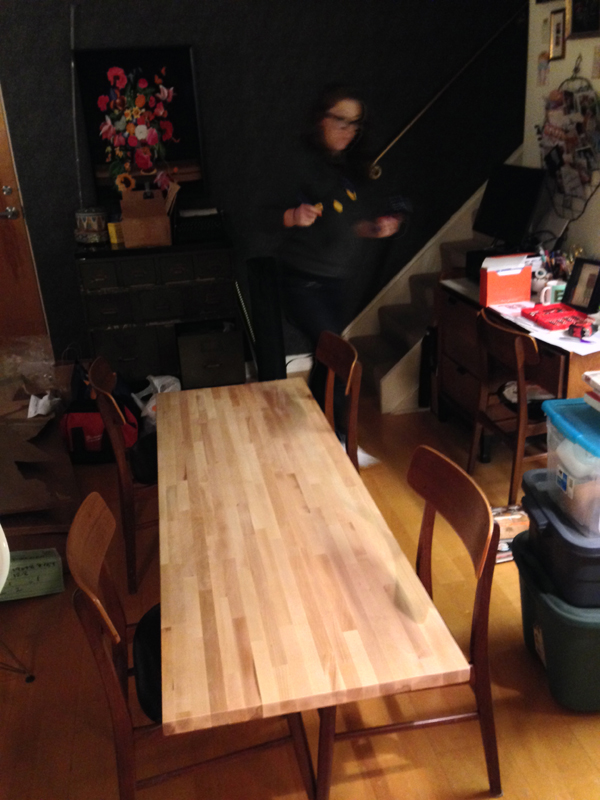
This is how you ‘make it work’ when you live in a loft. It’s during these few times that I actually envy those who live in the suburbs with their fancy garages and basements. Oh and did I mention that this was the week before Christmas? Forget snow, holidays in the loft were covered in a blanket of sawdust.
Can I get a woot! woot! for girls rock’n tools?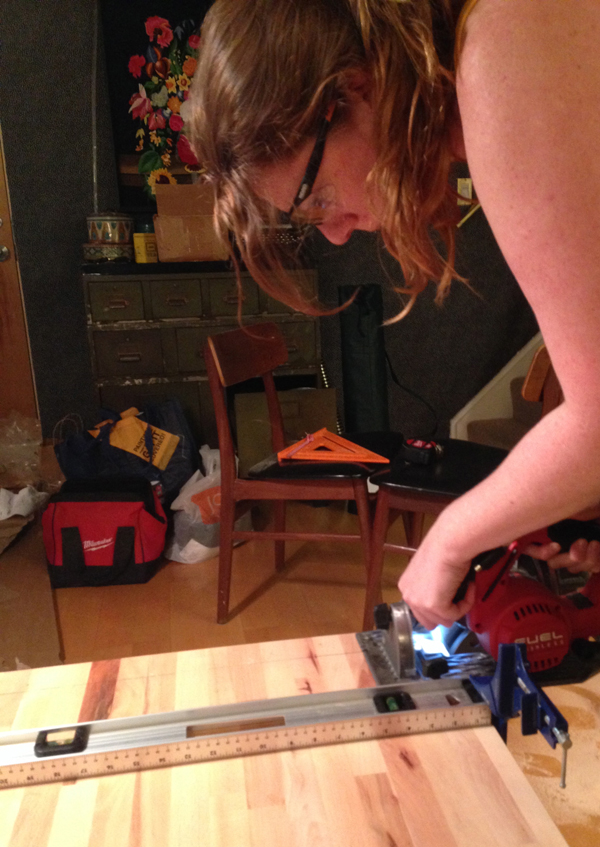 So once the cutting was done, I had something left like this. One step closer to a waterfall butcher block island.
So once the cutting was done, I had something left like this. One step closer to a waterfall butcher block island.
And oh yeah, just to make things easier, I also had to deal with an outlet.
I painted the front of the island in Tricorn Black by Sherwin Williams to match the cupboards that were spray painted by Paint it Like New. It takes more guts than I thought to take a roller of black paint to a clean slate. Also it should be noted that it would’ve made wayyyyyyy more sense for me to do this before the counters were on. But I was lazy. Let my mistake be a lesson to you.
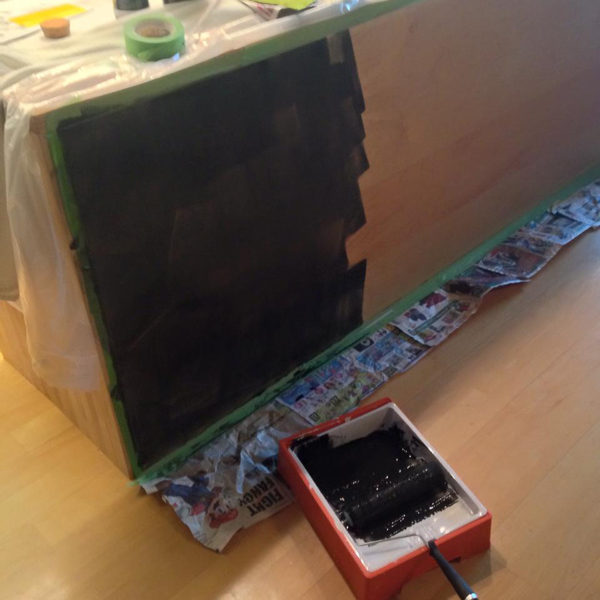 Next comes some more dirty work. The sanding, staining & sealing the wood.
Next comes some more dirty work. The sanding, staining & sealing the wood.
This is where I discovered the most amazing product ever in the world of DIY wood projects. If there was an oscar for this category, Rubio Monocoat would win. Everywhere I read online told me to use Waterlox for a food-safe seal for wood countertops. Like every. single. site. So I wasn’t going to fight the internet, I was going to use Waterlox. But who knew something so popular would be so hard to find. My search brought me to Exotic Woods in Burlington. While I was there they introduced me to an alternative called Rubio Monocoat.
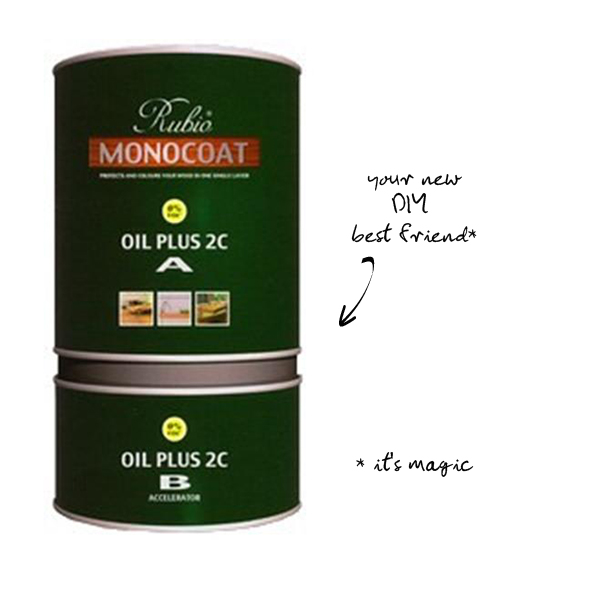 I’m about to compare wood finishing to hair removal but stay with me. If you’ve ever tried sugaring instead of waxing to remove body hair you were probably like “sure, they both do the job but this is sooooo much better, why isn’t more popular and why isn’t it offered everywhere?” That’s how I feel about this product. You will never go back to that multi-step stain + polyurethane monkey business after trying this.
I’m about to compare wood finishing to hair removal but stay with me. If you’ve ever tried sugaring instead of waxing to remove body hair you were probably like “sure, they both do the job but this is sooooo much better, why isn’t more popular and why isn’t it offered everywhere?” That’s how I feel about this product. You will never go back to that multi-step stain + polyurethane monkey business after trying this.
Here’s the awesomeness that is Monocoat:
• as per the name, you only need ONE coat, which also is more economical.
• it also comes in tints so it can be a stain and seal in one (vs 5 layers to do my shelves)
• it’s 100% VOC free, so not only is it food safe but you could drink it if you want
• it’s wayyyyy easier and dummy-safe to apply
• it’s also wayyyyy easier to do spot touch ups in the future vs doing over a whole piece with stain.
For the record – this is not a sponsored post. I just can’t get over how great this product is and it’s not everyday that I get so excited about a wood finishing product.
For best results, apply Monocoat to raw wood. Give it a really good sanding, working up to a really fine 220 sandpaper. The smoother the wood, the nicer the finish. If you just want to keep the natural colour of the wood, just use the clear Monocoat. I used Iced Brown.
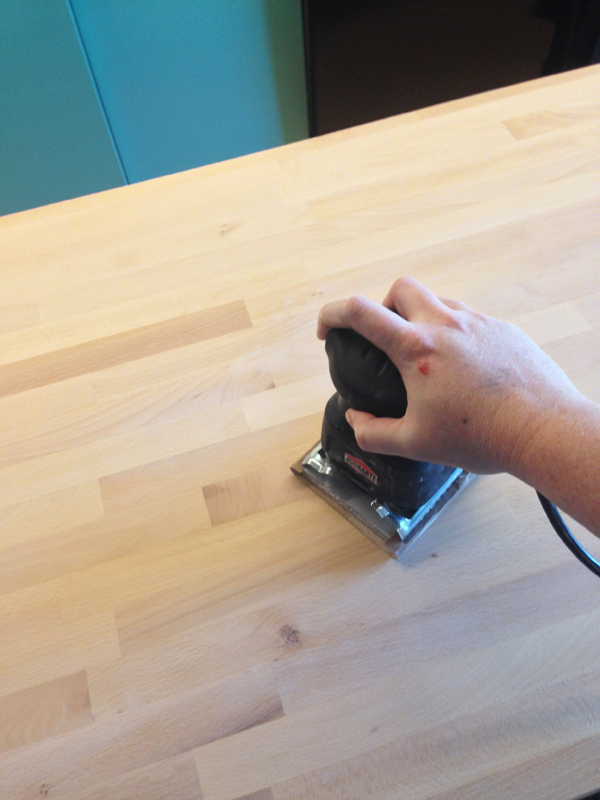 Make sure the wood is totally clean of any wood dust and dry before applying finish. Then follow the directions and mix the Monocoat solution. To apply you just need a straight edge, you can even use a credit card. Unlike stain, if you go over the same area it won’t darken more (wayyyy more user friendly). So just pour or paint on a small amount of the Monocoat then use the straight edge and spread it across the surface until you cover every inch.
Make sure the wood is totally clean of any wood dust and dry before applying finish. Then follow the directions and mix the Monocoat solution. To apply you just need a straight edge, you can even use a credit card. Unlike stain, if you go over the same area it won’t darken more (wayyyy more user friendly). So just pour or paint on a small amount of the Monocoat then use the straight edge and spread it across the surface until you cover every inch.
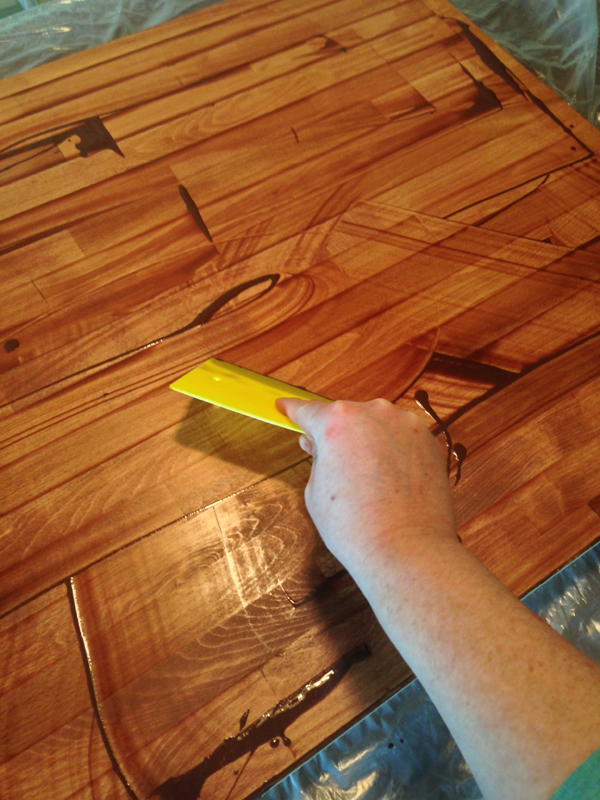 Let it set for about 15 minutes then rub off the excess with a micro-fibre rag and look at your stunning countertop. It should feel dry to the touch.
Let it set for about 15 minutes then rub off the excess with a micro-fibre rag and look at your stunning countertop. It should feel dry to the touch.
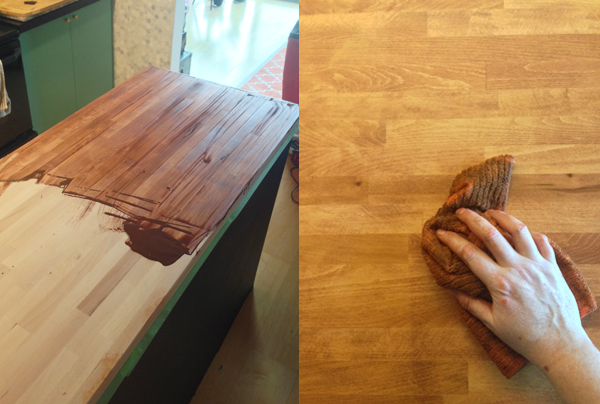 And another amazing thing about this product is that, although not recommended, it’s not the end of the world if you make a huge mess like this. You can just wipe it up and it won’t stain your floor (as long as it’s sealed and finished).
And another amazing thing about this product is that, although not recommended, it’s not the end of the world if you make a huge mess like this. You can just wipe it up and it won’t stain your floor (as long as it’s sealed and finished).
 Then you just sit back for 24 hours and admire your work. After 24 hours you can place items on it if you really need to but you can’t wash it or let it get in contact with liquids for 6 days to completely dry.
Then you just sit back for 24 hours and admire your work. After 24 hours you can place items on it if you really need to but you can’t wash it or let it get in contact with liquids for 6 days to completely dry.
Then you’ll have something like this:
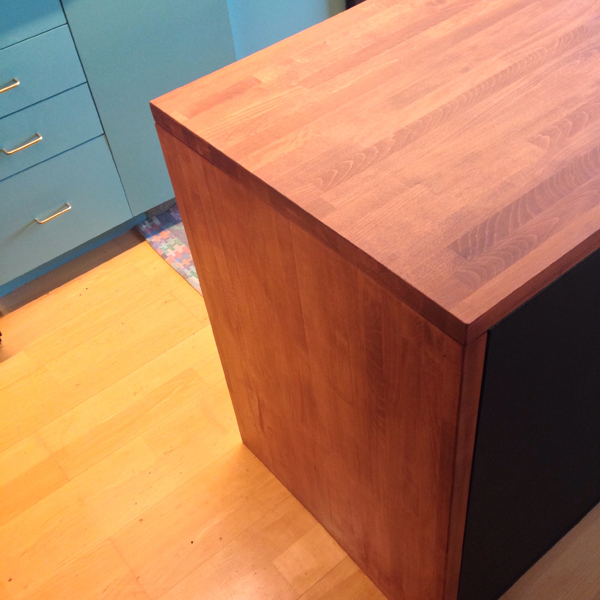
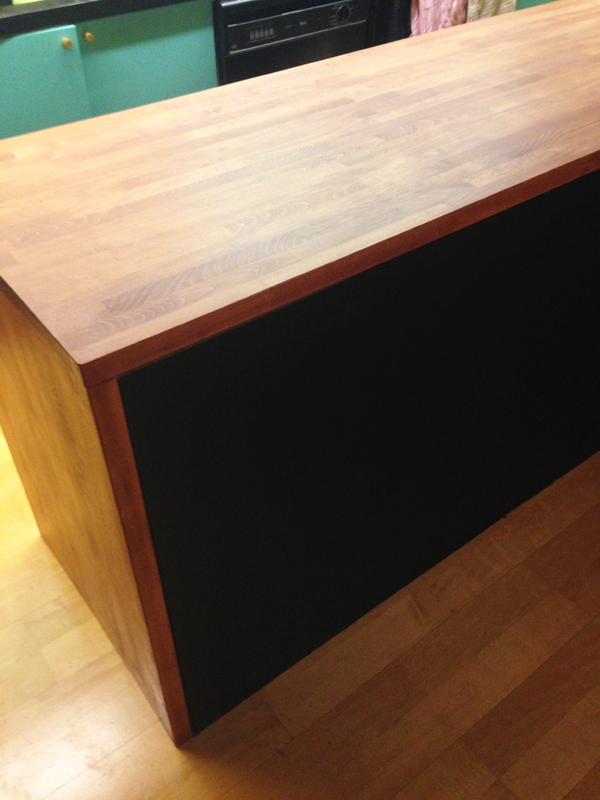 Honestly, I couldn’t be happier with the end result. It was a bit of a process, especially at the end of the road but like everything else with this project once it was done I felt good about it.
Honestly, I couldn’t be happier with the end result. It was a bit of a process, especially at the end of the road but like everything else with this project once it was done I felt good about it.
You’ll be able to see it in it’s full glory in the final reveal coming really soon. If you haven’t been following along, you can see all the kitchen updates here.
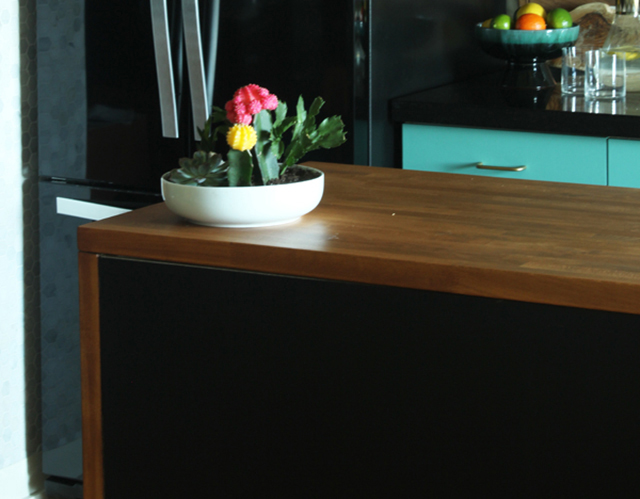
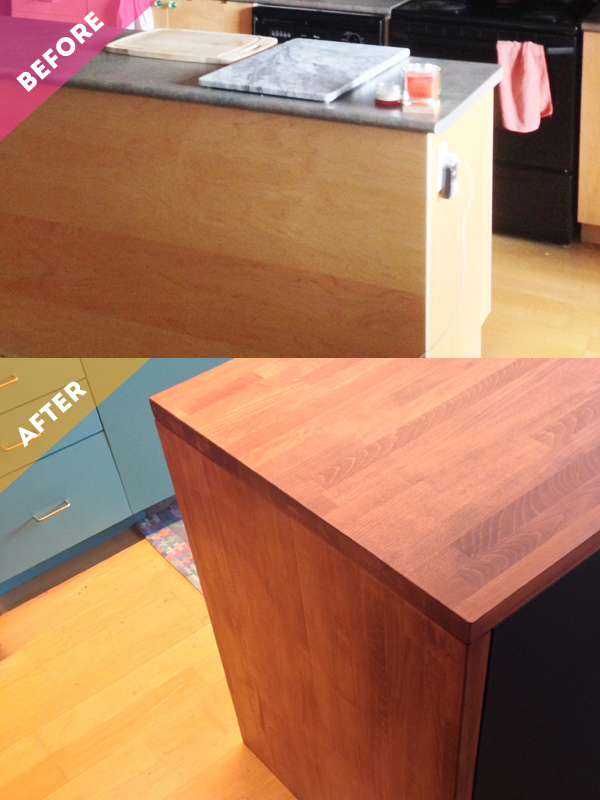
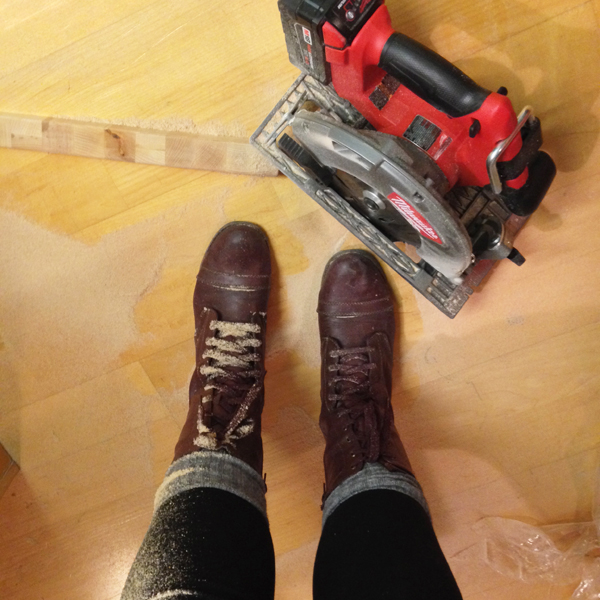

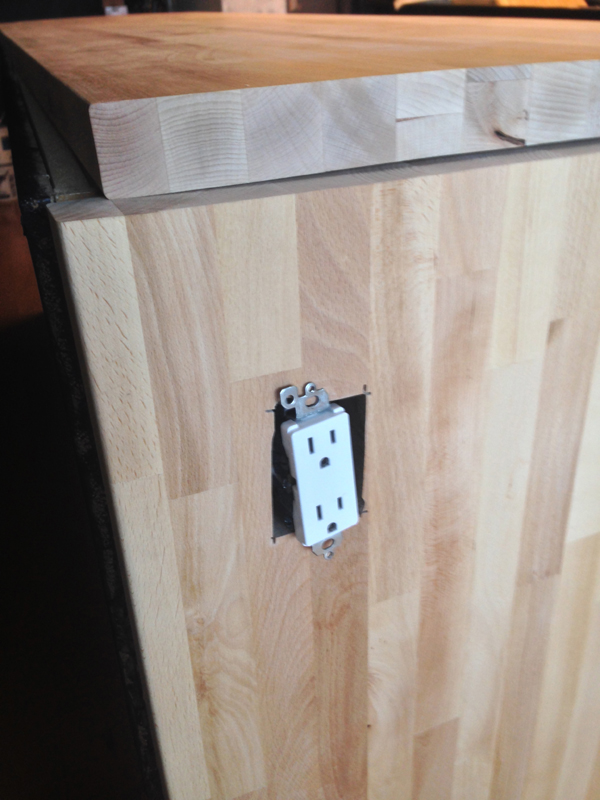
29 responses to “KITCHEN MAKEOVER: How to make a DIY waterfall butcher block island”
Looks AMAZING, Melissa! I cannot believe you did all the sawing indoors. Jeez – how long did it take to mop up all of that dust?
Thanks Jordana! Don’t ask about the mess! I honestly don’t know how people live through a full kitchen reno. A few cuts and some sanding and my place is a mess for weeks. The things we do for a pretty kitchen :)
Just looked up the stain/ sealer – it’s STUPID expensive. No idea why it could possibly cost anything close to what it does. Over $200!!!!!
How is the counter holding up?
It’s holding up great Michelle! I can’t say enough good things about the Monocoat. I honestly don’t know how it’s not more common. It’s amazing.
I’m thinking of doing this for my counter-for minor blemishes/scratches, how do you treat it? Do you use Rubio products to clean it regularly?
Also- did you monocoat only the tops and edges or did you monocoat the underside as well?
Hi Ali, I only applied the product the top and sides but mostly because I was being kind of lazy and was limited with space and time. It’s probably a good idea to do all sides. I use regular cleaning products (non-abrasive) to clean the surface. I recommend reaching out to a retailer or professional that sells Rubio for any really specific questions about best practices when applying the product.
How are the counter tops now? We have 4 kids and are only using wood on the island. We do not plan on using this for food preparation. However with 4 kids one is bound to put something on it, that shouldn’t be on it, example a strawberry would that stain the wood with the product you used? What about a drop of colored beverage?
It’s been a year and the island counter looks great. But keep in mind that I live by myself and tend to be quick to clean any stainable messes :) You should avoid using harsh chemical cleaners on it. Also what’s great with the Monocoat product is that if there’s some wear, you can just give it another coat and it will look brand new. The application is wayyyyyyyyy easier and painless compared to stain.
Hi! We’re planning on using monocoat for our counters too – with an undermount sink! Fingers crossed. Anyway, I was wondering if you use any of their products for cleaning and maintenance? Or what your cleaning and maintenance routine is like. Thanks so much!
Hi Beth, I honestly have nothing negative to say. My counter still looks great and I haven’t done any maintenance. I bought their concentrated cleaner and diluted it with water and put it in a spray bottle and use that. Or I just use regular all-surface cleaner when I make a big mess. Both have been fine.
Hi,
Good find on the rubio monocoat for this application..really looks good. Before you applied the product, did you just use mineral spirits or something else to clean the wood after the prep sanding?
thanks
I gave it a good sanding then just wiped well with a damp cloth and let it dry before applying the Rubio.
How did you connect the corners of top and side pieces?
Hi Eve, the top and bottom are not connected to each other – they are screwed into island and just measured to fit well
how did you connect the two pieces..I am wanting to do the same thing in my basement. Did you attach the piece to the floor with anything?
The two pieces are not connected to each other – they’re screwed into the island.
I am looking for the right solution for my birch Butcher block countertops that will be next to my sink, next to my stove, next to my dishwasher, everywhere basically.
I wanted to do a clear poly but everyone from my builder to the people at Home Depot are telling me not to do so, even if I’m not going to prepare food on my countertops.
The only thing that I want that the product you used does not seem to provide is a shiny finish.
And what happens if water gets on the surface of your counters? And how do you clean them?
Thanks!
Hi Susan, water is not an issue and you just clean them as you would with any counter. It’s mostly used on floors so it’s very durable. But also completely food-safe. I’m telling you, it’s the best product ever. I thought I remember there being a semi or glass option?? but i could be wrong.
Thanks for this! The final two pictures have sort of different lighting / color temperatures. Would you say the iced brown has reddish tones in the brown? The first finished picture shows it as a lot more reddish.
Hi JC. I would definitely say that there’s a warm red undertone to it but I would still say overall it’s brown. The lighting you choose in your space will also effect the temp.
The monocoat is a good stain/sealer option for butcher block but there are some potential issues if you decide to go with a highly figured wood such as birch or maple. These woods have that pretty chatoyant grain that glows from varying depths but this irregular grain causes challenges when finishing. These woods tend to look more blotchy and uneven when stained conventionally or with monocoat because of this ‘figure’. Typically, woodworkers lay down a layer of wood conditioner or shellac before staining to mitigate the blotchy, uneven absorption of stain, but that’s not an option with monocoat as you need it to bond directly to the wood. (If you used beech, oak, or walnut, you shouldn’t have this issue with grain ‘figure’.) If anyone does go with a birch or maple, you are likely going to have to water pop the wood and let dry completely before applying the monocoat finish. Water popping will open the pores more and evens out the absorptive ability of the wood. After it dries, you ‘knock down’ the raised grain of the wood by rubbing with steel wool. This process will provide a much more even appearance to the monocoat finished look. Look up water popping hardware floor. You will use the same process only you will likely just use a hand sprayer with distilled water and a clean and predampened cotton rag to wipe water evenly across the surface. It’s not difficult as with a countertop, you’re not dealing with more than 16 sq’ usually..you just have to focus on the details a little and use a headlamp to allow you to see the areas you water pop as you go along..
The other issue with using monocoat is that you really have to pay attention to the details in your prep sanding. If you are using a power sander, you will most likely have sanding swirls or patterns that will become more pronounced after applying the monocoat finish. I had to hand sand out these areas for a more even look. (It all depends on how far you will be viewing the butcher block from and what kind of lighting it will be under).
One problem that I had was that I only sanded up to 120 grit because I wanted the monocoat to penetrate deeper for more water resistance. Even though this was recommended when speaking with monocoat’s tech support, this may not be advisable when considering future repair/restoration. Monocoat is used in the floor finishing industry so the deeper penetration is usually recommended. The higher grit you sand the wood with, the smoother, and hence the finish will not penetrate as deep. So you may want to go up to 220 grit as the author did, and here’s why. I noticed on a couple of pieces I did awhile back where I sanded only to 120, when one of the pieces incurred deep gouging scratch divots, it made spot sanding repair tougher. The reason (as far as I can tell) that this was the case, is that because I had deeper penetration with the monocoat due to stopping prep sanding at 120, it took longer to get to bare wood. For example, after sanding to what I thought was bare wood, I apparently still had some monocoat finish residue that did not come up. After I reapplied monocoat to the damaged areas that I had spot sanded, they were noticeably lighter in color to the surrounding areas and this distinctly stood out and bothered my eye. The other problem is sanding the border area of the spot is more challenging when the stain penetrates deeper. So, after all things were considered, it may be advisable to sand to 220 or a little higher with spot repairs in mind. While the presumed downside may appear that less of the finish may penetrate the wood, the upside is that it may make any future spot repairs much easier as you will have to sand less to get to bare wood when you go to reapply oil and should be easier to blend those repaired areas into the the larger piece inconspicuously. Also, when you consider that having sand deeper to get to bare wood, it can create depth irregularities which can also compound the problem after refinishing.
UNDERMOUNT SINKS –
Another caveat for those using butcher block for undermount sink cutouts. Because you are cutting a hole in the middle of the butcher block, you will want to sand the newly exposed end grain on the left and right sides of the new cutout to a much smoother feel (using much higher grit sandpaper) than you would the top surface of the block. Google end grain of wood if not sure what that is. Without the cutout, you don’t have to worry about it. But since you are cutting a hole in the butcher block, you are creating visible end grain surfaces on the right and left side of the cutout when looking down at the butcher block (which will be visible when undermounting a sink). End grain is a sponge for stain finishes, so if you sand this area the same as the surface, it will soak up more stain than the surface and will be too dark and opaque (you will likely to lose the grain visbility because it absorbs too much). The general rule is to sand from 2.5 – 3x higher grit to the end grain than you use on the surface. In my case, I used 120 on the surface and on the inside depth of the right and left end grain portions of the cut, I sanded up to 400 grit and the stain absorbed perfectly. If you sand to 220, you still may be okay with 400 on the end grain. Just test this beforehand on spare cutoff butcher block pieces by sanding the endgrain parts different from the surface. Remember, the top and bottom portions of the cutout are not end grain so the higher grit sanding rule does not apply to those parts of the sink cutout (they are side grain, not end grain like the left and right sides).
I didn’t write this to dissuade anyone from using the product…just a detailed fyi. If you pay attention to the details, you will surprise yourself at how professional the job will look.
I just read a recall a notice for this product if you are reading this from Canada. Bummer because I ought I had found my dream product. Thank you, as well, J, for your thorough comment. Much appreciated.
http://healthycanadians.gc.ca/recall-alert-rappel-avis/hc-sc/2017/61798r-eng.php
Hi j,
With birch butcher block, will I still have blotchy issues if I use the pure/clear Rubio monocoat? Would you still recommend the water popping if I’m not staining the wood another color?
Thanks.
I’m seriously considering using Monocoat on my counter tops. I’m just wondering what cleaning products you use. Monocoat has a natural soap on their website, I can’t really tell if it would be good for counter tops or not, I’m guessing it’s made for floors. Have you used that? Do you have a different method for disinfecting the counter top? I’m just wanting to make sure I don’t hurt the finish with anything too harsh. I don’t plan to cut on the counter top, but I imagine food will be placed directly on them and I’d like to be able to clean them up at the end of the day.
Thanks,
I use the Monocoat soap. I diluted it with water and put it in a spray bottle. The formula is so concentrated that it last me for ages. I make a point not to put meats on it and definitely don’t cut your food on it because you’ll ruin your counter but it’s food safe, yes.
How much sanding and what grits did you use to get to the raw wood on the Birch Ikea counter. We’re using the Walnut Monocoat, and the finish is quite blotchy.
Darn, it was so long ago I don’t remember. I remember giving it a good sanding with a med and then a fine grit but I didn’t have to go crazy and I didn’t have any issues with blotchiness. I’m definitely an impatient type person that isn’t known to over-prep, ha! Sorry I can’t be more help!